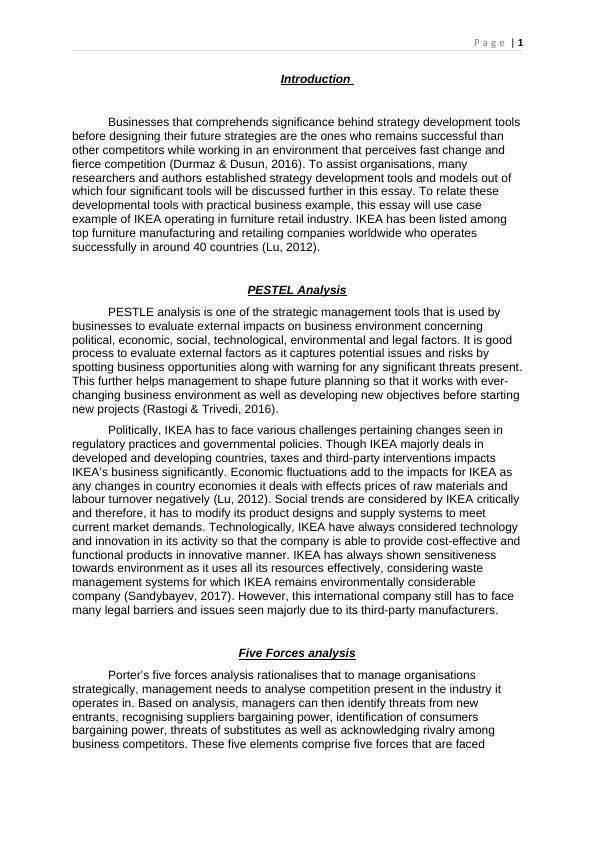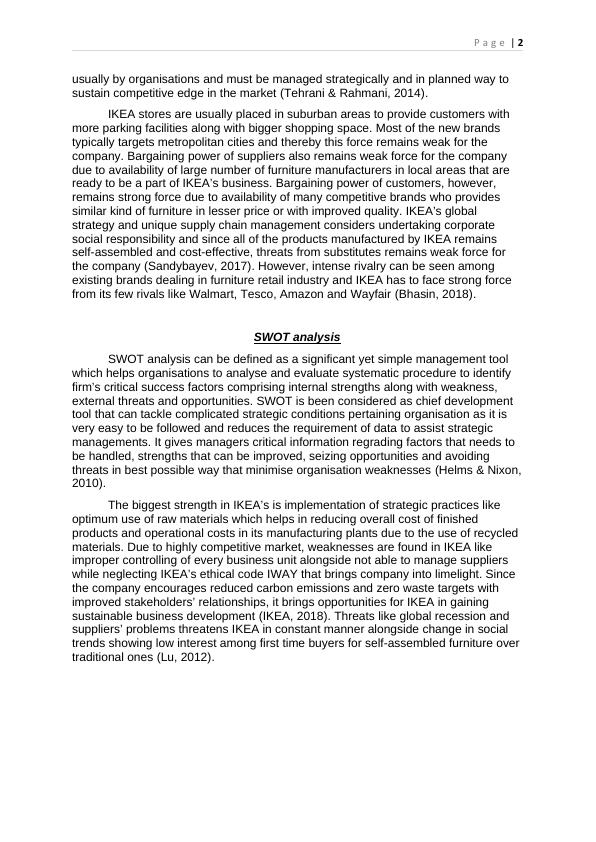Strategy Development Tools for Business Success: A Case Study of IKEA
Added on 2023-01-18
6 Pages1644 Words36 Views
Student Name
INSTITUTIONAL AFFILIATION(S)
MASTERS IN BUSINESS
ADMINISTRATION
INSTITUTIONAL AFFILIATION(S)
MASTERS IN BUSINESS
ADMINISTRATION

P a g e | 1
Introduction
Businesses that comprehends significance behind strategy development tools
before designing their future strategies are the ones who remains successful than
other competitors while working in an environment that perceives fast change and
fierce competition (Durmaz & Dusun, 2016). To assist organisations, many
researchers and authors established strategy development tools and models out of
which four significant tools will be discussed further in this essay. To relate these
developmental tools with practical business example, this essay will use case
example of IKEA operating in furniture retail industry. IKEA has been listed among
top furniture manufacturing and retailing companies worldwide who operates
successfully in around 40 countries (Lu, 2012).
PESTEL Analysis
PESTLE analysis is one of the strategic management tools that is used by
businesses to evaluate external impacts on business environment concerning
political, economic, social, technological, environmental and legal factors. It is good
process to evaluate external factors as it captures potential issues and risks by
spotting business opportunities along with warning for any significant threats present.
This further helps management to shape future planning so that it works with ever-
changing business environment as well as developing new objectives before starting
new projects (Rastogi & Trivedi, 2016).
Politically, IKEA has to face various challenges pertaining changes seen in
regulatory practices and governmental policies. Though IKEA majorly deals in
developed and developing countries, taxes and third-party interventions impacts
IKEA’s business significantly. Economic fluctuations add to the impacts for IKEA as
any changes in country economies it deals with effects prices of raw materials and
labour turnover negatively (Lu, 2012). Social trends are considered by IKEA critically
and therefore, it has to modify its product designs and supply systems to meet
current market demands. Technologically, IKEA have always considered technology
and innovation in its activity so that the company is able to provide cost-effective and
functional products in innovative manner. IKEA has always shown sensitiveness
towards environment as it uses all its resources effectively, considering waste
management systems for which IKEA remains environmentally considerable
company (Sandybayev, 2017). However, this international company still has to face
many legal barriers and issues seen majorly due to its third-party manufacturers.
Five Forces analysis
Porter’s five forces analysis rationalises that to manage organisations
strategically, management needs to analyse competition present in the industry it
operates in. Based on analysis, managers can then identify threats from new
entrants, recognising suppliers bargaining power, identification of consumers
bargaining power, threats of substitutes as well as acknowledging rivalry among
business competitors. These five elements comprise five forces that are faced
Introduction
Businesses that comprehends significance behind strategy development tools
before designing their future strategies are the ones who remains successful than
other competitors while working in an environment that perceives fast change and
fierce competition (Durmaz & Dusun, 2016). To assist organisations, many
researchers and authors established strategy development tools and models out of
which four significant tools will be discussed further in this essay. To relate these
developmental tools with practical business example, this essay will use case
example of IKEA operating in furniture retail industry. IKEA has been listed among
top furniture manufacturing and retailing companies worldwide who operates
successfully in around 40 countries (Lu, 2012).
PESTEL Analysis
PESTLE analysis is one of the strategic management tools that is used by
businesses to evaluate external impacts on business environment concerning
political, economic, social, technological, environmental and legal factors. It is good
process to evaluate external factors as it captures potential issues and risks by
spotting business opportunities along with warning for any significant threats present.
This further helps management to shape future planning so that it works with ever-
changing business environment as well as developing new objectives before starting
new projects (Rastogi & Trivedi, 2016).
Politically, IKEA has to face various challenges pertaining changes seen in
regulatory practices and governmental policies. Though IKEA majorly deals in
developed and developing countries, taxes and third-party interventions impacts
IKEA’s business significantly. Economic fluctuations add to the impacts for IKEA as
any changes in country economies it deals with effects prices of raw materials and
labour turnover negatively (Lu, 2012). Social trends are considered by IKEA critically
and therefore, it has to modify its product designs and supply systems to meet
current market demands. Technologically, IKEA have always considered technology
and innovation in its activity so that the company is able to provide cost-effective and
functional products in innovative manner. IKEA has always shown sensitiveness
towards environment as it uses all its resources effectively, considering waste
management systems for which IKEA remains environmentally considerable
company (Sandybayev, 2017). However, this international company still has to face
many legal barriers and issues seen majorly due to its third-party manufacturers.
Five Forces analysis
Porter’s five forces analysis rationalises that to manage organisations
strategically, management needs to analyse competition present in the industry it
operates in. Based on analysis, managers can then identify threats from new
entrants, recognising suppliers bargaining power, identification of consumers
bargaining power, threats of substitutes as well as acknowledging rivalry among
business competitors. These five elements comprise five forces that are faced

P a g e | 2
usually by organisations and must be managed strategically and in planned way to
sustain competitive edge in the market (Tehrani & Rahmani, 2014).
IKEA stores are usually placed in suburban areas to provide customers with
more parking facilities along with bigger shopping space. Most of the new brands
typically targets metropolitan cities and thereby this force remains weak for the
company. Bargaining power of suppliers also remains weak force for the company
due to availability of large number of furniture manufacturers in local areas that are
ready to be a part of IKEA’s business. Bargaining power of customers, however,
remains strong force due to availability of many competitive brands who provides
similar kind of furniture in lesser price or with improved quality. IKEA’s global
strategy and unique supply chain management considers undertaking corporate
social responsibility and since all of the products manufactured by IKEA remains
self-assembled and cost-effective, threats from substitutes remains weak force for
the company (Sandybayev, 2017). However, intense rivalry can be seen among
existing brands dealing in furniture retail industry and IKEA has to face strong force
from its few rivals like Walmart, Tesco, Amazon and Wayfair (Bhasin, 2018).
SWOT analysis
SWOT analysis can be defined as a significant yet simple management tool
which helps organisations to analyse and evaluate systematic procedure to identify
firm’s critical success factors comprising internal strengths along with weakness,
external threats and opportunities. SWOT is been considered as chief development
tool that can tackle complicated strategic conditions pertaining organisation as it is
very easy to be followed and reduces the requirement of data to assist strategic
managements. It gives managers critical information regrading factors that needs to
be handled, strengths that can be improved, seizing opportunities and avoiding
threats in best possible way that minimise organisation weaknesses (Helms & Nixon,
2010).
The biggest strength in IKEA’s is implementation of strategic practices like
optimum use of raw materials which helps in reducing overall cost of finished
products and operational costs in its manufacturing plants due to the use of recycled
materials. Due to highly competitive market, weaknesses are found in IKEA like
improper controlling of every business unit alongside not able to manage suppliers
while neglecting IKEA’s ethical code IWAY that brings company into limelight. Since
the company encourages reduced carbon emissions and zero waste targets with
improved stakeholders’ relationships, it brings opportunities for IKEA in gaining
sustainable business development (IKEA, 2018). Threats like global recession and
suppliers’ problems threatens IKEA in constant manner alongside change in social
trends showing low interest among first time buyers for self-assembled furniture over
traditional ones (Lu, 2012).
usually by organisations and must be managed strategically and in planned way to
sustain competitive edge in the market (Tehrani & Rahmani, 2014).
IKEA stores are usually placed in suburban areas to provide customers with
more parking facilities along with bigger shopping space. Most of the new brands
typically targets metropolitan cities and thereby this force remains weak for the
company. Bargaining power of suppliers also remains weak force for the company
due to availability of large number of furniture manufacturers in local areas that are
ready to be a part of IKEA’s business. Bargaining power of customers, however,
remains strong force due to availability of many competitive brands who provides
similar kind of furniture in lesser price or with improved quality. IKEA’s global
strategy and unique supply chain management considers undertaking corporate
social responsibility and since all of the products manufactured by IKEA remains
self-assembled and cost-effective, threats from substitutes remains weak force for
the company (Sandybayev, 2017). However, intense rivalry can be seen among
existing brands dealing in furniture retail industry and IKEA has to face strong force
from its few rivals like Walmart, Tesco, Amazon and Wayfair (Bhasin, 2018).
SWOT analysis
SWOT analysis can be defined as a significant yet simple management tool
which helps organisations to analyse and evaluate systematic procedure to identify
firm’s critical success factors comprising internal strengths along with weakness,
external threats and opportunities. SWOT is been considered as chief development
tool that can tackle complicated strategic conditions pertaining organisation as it is
very easy to be followed and reduces the requirement of data to assist strategic
managements. It gives managers critical information regrading factors that needs to
be handled, strengths that can be improved, seizing opportunities and avoiding
threats in best possible way that minimise organisation weaknesses (Helms & Nixon,
2010).
The biggest strength in IKEA’s is implementation of strategic practices like
optimum use of raw materials which helps in reducing overall cost of finished
products and operational costs in its manufacturing plants due to the use of recycled
materials. Due to highly competitive market, weaknesses are found in IKEA like
improper controlling of every business unit alongside not able to manage suppliers
while neglecting IKEA’s ethical code IWAY that brings company into limelight. Since
the company encourages reduced carbon emissions and zero waste targets with
improved stakeholders’ relationships, it brings opportunities for IKEA in gaining
sustainable business development (IKEA, 2018). Threats like global recession and
suppliers’ problems threatens IKEA in constant manner alongside change in social
trends showing low interest among first time buyers for self-assembled furniture over
traditional ones (Lu, 2012).

End of preview
Want to access all the pages? Upload your documents or become a member.
Related Documents
Competitive Strategy: PESTEL, Five Forces, SWOT, and Generic Strategieslg...
|6
|1460
|248
Competitive Strategy: Porter Five Forces, SWOT, PESTLE Analysislg...
|10
|1611
|301
Competitive dynamics of IKEA Indialg...
|11
|3095
|494
Strategic Management in IKEA PDFlg...
|20
|4505
|127
Effective Global Marketing for IKEAlg...
|14
|3436
|75
Industry Analysis of Woolworths: Porter 5 Force Analysislg...
|6
|829
|384
